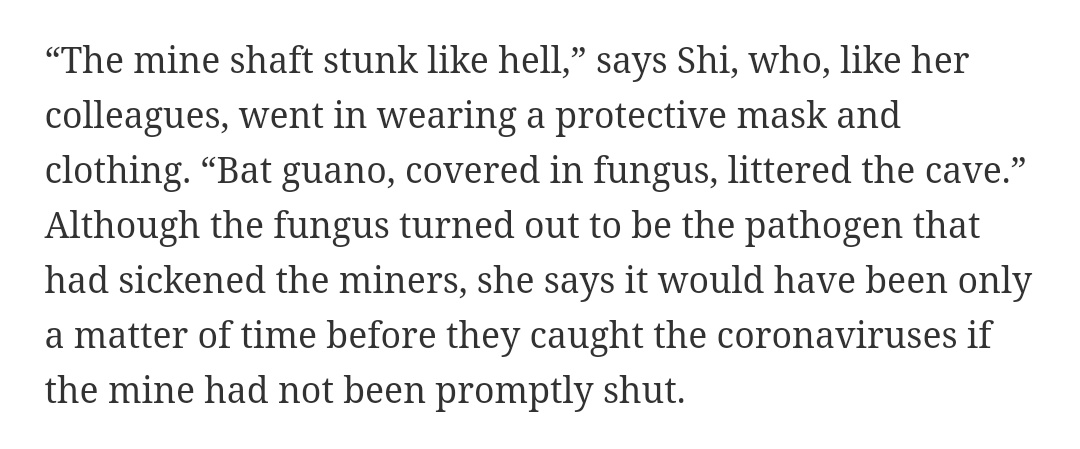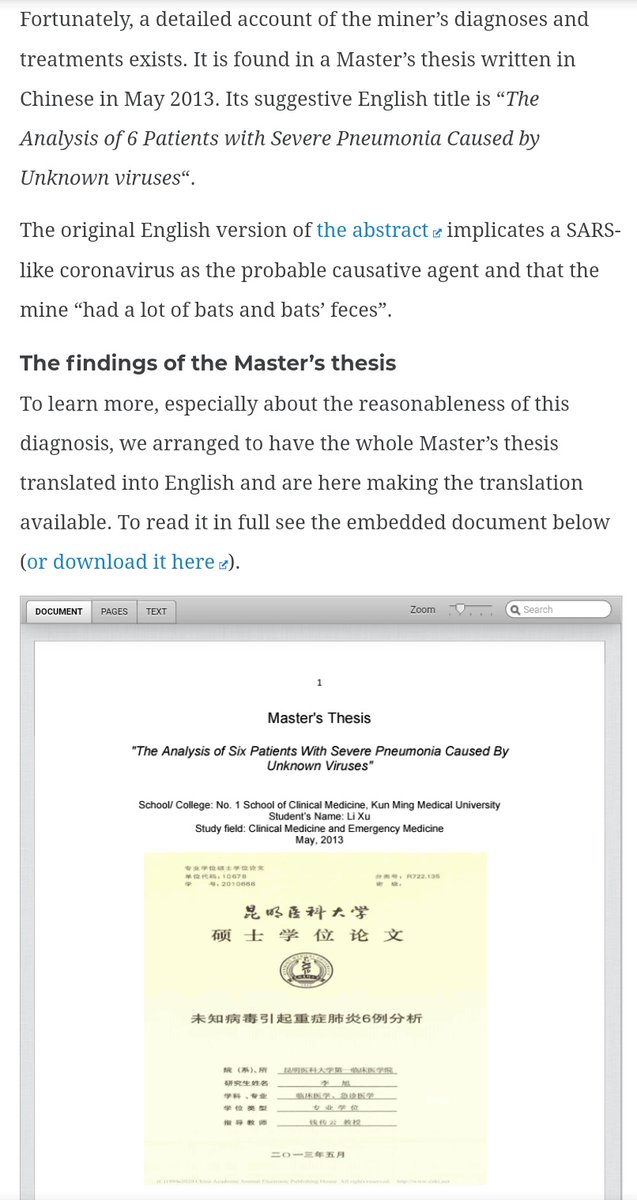... they just came right out and said it. https://twitter.com/OneOfMany3421/status/1306671434790510595?s=19
Thread:
https://twitter.com/PeterDaszak/status/1197631383470034951?s=19
Stamps:
https://twitter.com/tweet_stamp/status/1306673528121503744?s=19 https://twitter.com/tweet_stamp/status/1306673603736416258?s=19
https://twitter.com/PeterDaszak/status/1197631383470034951?s=19
Stamps:
https://twitter.com/tweet_stamp/status/1306673528121503744?s=19 https://twitter.com/tweet_stamp/status/1306673603736416258?s=19
Further discussion here also:
https://twitter.com/R_H_Ebright/status/1253132609238024195?s=19
Systematic gain-of-function studies against hACE2 and humanized model animals using recombinant methods to modify Spike across dozens of novel undisclosed bat CoVs had recently begun at WIV at the time of the outbreak.
https://twitter.com/R_H_Ebright/status/1253132609238024195?s=19
Systematic gain-of-function studies against hACE2 and humanized model animals using recombinant methods to modify Spike across dozens of novel undisclosed bat CoVs had recently begun at WIV at the time of the outbreak.
I have also gone to the trouble of submitting each pdf in the thread at their source to the Internet Archive.
https://web.archive.org/web/20200917193618/https://www.ecohealthalliance.org/wp-content/uploads/2016/02/Ge-et-al-Bat-SARS-like-CoV-that-uses-ACE2-Nature-2013.pdf
https://web.archive.org/web/20200917193719/https://www.ecohealthalliance.org/wp-content/uploads/2016/02/Li-et-al_Science_Bats-as-reservoir-for-SARS.pdf
https://web.archive.org/web/20200917193758/https://www.ecohealthalliance.org/wp-content/uploads/2018/03/Virologica-Sinica-SARSr.pdf
Published and available elsewhere, of course, but hopefully a useful combined collection.
https://web.archive.org/web/20200917193618/https://www.ecohealthalliance.org/wp-content/uploads/2016/02/Ge-et-al-Bat-SARS-like-CoV-that-uses-ACE2-Nature-2013.pdf
https://web.archive.org/web/20200917193719/https://www.ecohealthalliance.org/wp-content/uploads/2016/02/Li-et-al_Science_Bats-as-reservoir-for-SARS.pdf
https://web.archive.org/web/20200917193758/https://www.ecohealthalliance.org/wp-content/uploads/2018/03/Virologica-Sinica-SARSr.pdf
Published and available elsewhere, of course, but hopefully a useful combined collection.
Minor note--
The gain-of-function studies disclosed in papers and grants associated with the WIV's bat CoV research do not imply the design of a particular single 'candidate' strain.
Past work developed several, reporting on various characteristics. https://twitter.com/__ice9/status/1306694599453429761?s=19
The gain-of-function studies disclosed in papers and grants associated with the WIV's bat CoV research do not imply the design of a particular single 'candidate' strain.
Past work developed several, reporting on various characteristics. https://twitter.com/__ice9/status/1306694599453429761?s=19
Meanwhile, evidence from the RaTG13 sequencing datasets strongly implies that southern Chinese bat CoV full genome sequencing had been ongoing without disclosure of the results to international databases for at least two years prior to the outbreak. https://twitter.com/Ayjchan/status/1306993218408587267?s=19
Also, direct evidence that the backbone in these studies was not always a pseudovirus or SARS-CoV, even in 2008.
This paper did the reverse: generate synthetic consensus Bat-SCoV, swap in SARS-CoV RBD, test in cells and mice.
https://www.pnas.org/content/105/50/19944
Grant merely generalized.
This paper did the reverse: generate synthetic consensus Bat-SCoV, swap in SARS-CoV RBD, test in cells and mice.
https://www.pnas.org/content/105/50/19944
Grant merely generalized.
Likewise, the 2015 Baric and Shi paper (includes researchers at WIV by 2019) used mouse-adapted SARS-CoV as a backbone instead of ordinary SARS-CoV.
https://www.med.unc.edu/orfeome/files/2018/03/a-sars-like-cluster-of-circulating-bat-coronaviruses-shows-potential-for-human-emergence.pdf
Fully synthetic recombinant virus used for an emergence study. The grant extended this specific work.
https://www.med.unc.edu/orfeome/files/2018/03/a-sars-like-cluster-of-circulating-bat-coronaviruses-shows-potential-for-human-emergence.pdf
Fully synthetic recombinant virus used for an emergence study. The grant extended this specific work.
The grant described screening a new sample of apparently >50 SARS-like CoVs vs. human ACE2 and testing recombinants in humanized mice.
Note emphasis on pathogenicity in all of these papers. The backbone matters (e.g. SARS is deadlier in part because of better IFN suppression).
Note emphasis on pathogenicity in all of these papers. The backbone matters (e.g. SARS is deadlier in part because of better IFN suppression).
Hence, to properly understand potential emergence harms from this broader sampled set in humanized mice, the most logical approach is using both backbones and RBDs drawn from the set.
Fully synthetic methods and whole-genome sequences were already available, as shown above.
Fully synthetic methods and whole-genome sequences were already available, as shown above.
The goal? Likely to assess human emergence risk from the Mojiang Yunnan cave. 6 miners were infected; 2 died.
Shi lied, claiming fungal infection:
https://www.scientificamerican.com/article/how-chinas-bat-woman-hunted-down-viruses-from-sars-to-the-new-coronavirus1/
But a translated thesis proves it was a bat CoV:
https://www.independentsciencenews.org/commentaries/a-proposed-origin-for-sars-cov-2-and-the-covid-19-pandemic/
Shi lied, claiming fungal infection:
https://www.scientificamerican.com/article/how-chinas-bat-woman-hunted-down-viruses-from-sars-to-the-new-coronavirus1/
But a translated thesis proves it was a bat CoV:
https://www.independentsciencenews.org/commentaries/a-proposed-origin-for-sars-cov-2-and-the-covid-19-pandemic/
This cave also yielded: RaTG13.
In spite of initial doubts, the latest analysis linked above via @Ayjchan strongly suggests RaTG13 is indeed real.
And RaTG13 is the closest known match to SARS-CoV-2, >96%.
In spite of initial doubts, the latest analysis linked above via @Ayjchan strongly suggests RaTG13 is indeed real.
And RaTG13 is the closest known match to SARS-CoV-2, >96%.
So the "bat woman of China," who contributed to the hunt for SARS and this covered-up CoV of the Mojiang miners ('threat for human emergence' it already happened) had a grant for systematic recombination studies-- including further Yunnan samples.
Wuhan is 1900 km from Yunnan.
Wuhan is 1900 km from Yunnan.
96% similarity between RaTG13 and SARS-CoV-2, grant funding for recombinantly optimizing hACE2 binding over this class of CoVs and infecting humanized mice, undisclosed existence of the full RaTG13 sequence and likely others since at least 2017, 4 separate cave sampling trips,

 Read on Twitter
Read on Twitter







